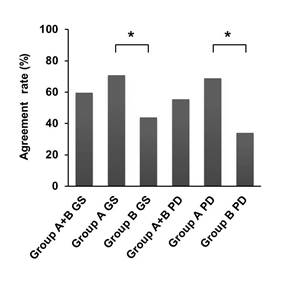Session Information
Date: Sunday, November 8, 2015
Title: Imaging of Rheumatic Diseases Poster I: Ultrasound, Optical Imaging and Capillaroscopy
Session Type: ACR Poster Session A
Session Time: 9:00AM-11:00AM
Background/Purpose: Musculoskeletal
ultrasonography (US) is a useful tool for the diagnosis and monitoring of
rheumatoid arthritis (RA). It is also helpful for promoting patient-clinician
communication by visualizing real-time disease activity. Although patients often request assessment
of the most symptomatic joints, there is no evidence for benefits associated
with assessment of a selected joint on demand from patients. Here we
investigated whether the patient’s subjective evaluation for the most affected
joint agrees with US assessment.
Methods:
Power Doppler (PD) US was performed in 8 joints,
including bilateral MCP 2, MCP 3, wrist and knee joints, as a routine
examination in a cumulative total of 406 patients with RA. At the examination,
patients declared the most symptomatically affected joint. In patients who had
the most affected joint except the routine 8 joints, the joint was additionally
scanned. PD signals and gray-scale (GS) images were scored semiquantitatively
from 0 to 3 in each joint. If PD or GS score
of the declared joint was the highest of the scores of scanned joints, the patient’s evaluation was regarded as agreeing with US
assessment.
Results: Forty-nine patients were asymptomatic. The remaining
patients were divided into two groups based on the most symptomatic joints.
Group A consisted of 209 patients having the most symptomatic joint among the
routine 8 joints, whereas 148 patients having the most symptomatic joint other
than the routine 8 joints were included in Group B. In
five patients (3.4%) of Group B, PD signals were detected in the most symptomatic
joints (shoulder, elbow, MCP 1, and 2 ankles), despite the negative results in
the routine 8 joint assessments. In the symptomatic
group (Group A and B), the agreement rates of the patient’s evaluation with PD and
GS scores were 64.4% and 60.2%, respectively. The agreement rate with PD score
in Group B was significantly lower than in Group A (51.4% vs 73.7%, P = 1.9 x 10-5). The agreement rate with GS score in Group B was also
significantly lower than in Group A (45.3% vs 70.8%, P = 1.3 x 10-6). Among the
cases having positive PD score in any joints (n = 285), the agreement rate with PD score was 55.4% in the
symptomatic group (Figure 1). The agreement rate with
PD score in Group B (n = 109) was
significantly lower than Group A (n = 176) (33.9% vs 68.8%, P = 1.2 x 10-8). Among the
cases having positive GS score in any joints (n = 352), the agreement rate with GS score was 59.7% in the
symptomatic group (Figure 1). The agreement rate with
GS score in Group B (n = 144) was
significantly lower than Group A (n =
208) (43.8% vs 70.7%, P = 5.6 x
10-7).
Conclusion: This study suggests that agreement between patient’s subjective
evaluation and US assessment on the most affected joints was quite poor,
especially in case the most symptomatic joint was not included in the routine 8
joints.
Figure
1 The agreement rates of the
patient’s evaluation with US assessment on the most
affected joints in RA cases with positive US scores.
To cite this abstract in AMA style:
Yoshimi R, Toyota Y, Tsuchida N, Sugiyama Y, Kunishita Y, Kishimoto D, Kamiyama R, Minegishi K, Hama M, Kirino Y, Takeno M, Ueda A, Ishigatsubo Y. Considerable Discrepancy Between Patient’s Assessment and Ultrasonography Assessment on the Most Affected Joint in Rheumatoid Arthritis [abstract]. Arthritis Rheumatol. 2015; 67 (suppl 10). https://acrabstracts.org/abstract/considerable-discrepancy-between-patients-assessment-and-ultrasonography-assessment-on-the-most-affected-joint-in-rheumatoid-arthritis/. Accessed .« Back to 2015 ACR/ARHP Annual Meeting
ACR Meeting Abstracts - https://acrabstracts.org/abstract/considerable-discrepancy-between-patients-assessment-and-ultrasonography-assessment-on-the-most-affected-joint-in-rheumatoid-arthritis/

